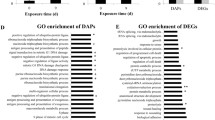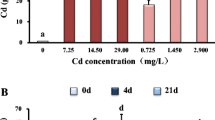Abstract
Heavy metals, including cadmium (Cd), are widespread pollutants of great environmental concern because of their accumulation and toxicity. Environmental conditions can affect the accumulation and elimination of Cd in organisms. The aim of this study is to understand the respective responses of metallothioneins (MTs), P-glycoprotein (P-gp), and heat shock protein 70 (hsp70) genes in the mantle and digestive gland of the oyster Crassostrea gigas exposed to 10 µg L−1 Cd for 28 days, followed by a depuration period of 35 days under different feeding strategies. The MT expression in the digestive gland was higher than in mantle, and was induced in a fluctuating pattern throughout the time of the whole experiment when the oyster was exposed to Cd. The results indicated an enhanced MT activity is required for Cd detoxification. Expression levels of P-gp in the mantle of Cd-exposed oysters fed with algae increased in the first two weeks of the accumulation phase. Then the induction weakened, but the expression still increased significantly compared with the control group fed without algae. The P-gp levels in the digestive gland were under-regulated during both the contamination and decontamination periods except in the group fed with Dicrateria inornata at day 0.083. The induction of P-gp is possibly related to the important role of pumping Cd out of the cell, while a major implication of P-gp expression inhibition would be a disruption of the protein synthesis. Hsp70 expression exhibited an overall decreasing trend. The highest relative hsp70 inhibition occurred during day 42 to day 63, with approximately 4-fold and 10-fold lower hsp70 levels as compared to the C.gigas feeding with no algae in the mantle and digestive gland, respectively. The induction of hsp70 may be explained by the refolding of protein in presence of Cd, followed by the inhibition of hsp70 when the protein synthesis was disrupted.
Similar content being viewed by others
References
Boutet, I., Tanguy, A., Rousseau, S., Auffret, M., and Moraga, D., 2003. Molecular identification and expression of heat shock cognate 70 (hsc70) and heat shock protein 70 (hsp70) genes in the Pacific oyster Crassostrea gigas. Cell Stress & Chaperon, 8 (1): 76–85.
Benavides, M. P., Gallego, S. M., and Tomaro, M. L., 2005. Cadmium toxicity in plants. Brazilian Journal of Plant Physiology, 17: 21–34.
Blackmore, G., and Wang, W. X., 2003. Inter-population differences in Cd, Cr, Se and Zn accumulation by the green mussel perna viridis acclimated at different salinities. Aquatic Toxicology, 62: 205–218.
Cheng, H. S., 2004. Kineties and physiological effects of heavy metals in Ostrea rivularis. Master thesis. Jinan University.
Della Torre, C., Zaja, R., Loncar, J., Smital, T., Focardi, S., and Corsi, I., 2012. Interaction of ABC transport proteins with toxic metals at the level of gene and transport activity in the PLHC-1 fish cell line. Chemico-Biological Interactions, 198: 9–17.
Dutton, J., and Fisher, N. S., 2011. Salinity effects on the bioavailability of aqueous metals for the estuarine killifish Fundulus heteroclitus. Environmental Toxicology Chemistry, 30 (9): 2107–2114.
Espinoza, H., Williams, C., and Gallagher, E., 2012. Effect of cadmium on glutathione S-transferase and metallothionein gene expression in coho salmon liver, gill and olfactory tissues. Aquatic Toxicology, 110–111: 37–44.
Franzellitti, S., and Fabbri, E., 2006. Cytoprotective responses in the Mediterranean mussel exposed to Hg2+ and CH3Hg+. Biochemical and Biophysical Research Communications, 351: 719–725.
Gueguen, Y., Denis, S., Adrien, S., Kevin, M., Pierre, G., Solène, B., Marine, N., Patrick, B., Herehia, H., Serge, P., and Gilles, L. M., 2017. Response of the pearl oyster Pinctada margaritifera to cadmium and chromium: Identification of molecular biomarkers. Marine Pollution Bulletin, 118 (1–2): 420–726.
Hindarti, D., Spickett, J. T., and Evans, L. H., 2000. Distribution of cadmium in the cockle Katelysia scalarina in Princess Royal Harbour, Albany, western Australia. Environmental Toxicology, 15 (1): 40–47.
Ivanina, A. V., and Sokolova, I. M., 2008. Effects of cadmium exposure on expression and activity of P-glycoprotein in eastern oysters, Crassostrea virginica Gmelin. Aquatic Toxicology, 88: 19–28.
Ivanina, A. V., Hawkins, C., Beniash, E., and Sokolova, I. M., 2015. Effects of environmental hypercapnia and metal (Cd and Cu) exposure on acid-base and metal homeostasis of marine bivalves. Comparative Biochemistry and Physiology Part C: Toxicology & Pharmacology, 174–175 (1): 1–12.
Jackson, C. S., Sneddon, J., Heagler, M. G., Lindow, A. G., and Beck, J. N., 2003. Use of flame atomic absorption spectrometry and the effect of water chemistry for the study of the bioaccumulation of cadmium in Menidia beryllina (Cope), the tidewater silverside. Microchemical Journal, 75: 23–28.
Jenny, M. J., Ringwood, A. H., Schey, K., Warr, G. W., and Chapman, R. W., 2004. Diversity of metallothioneins in the American oyster, Crassostrea virginica, revealed bytranscriptomic and proteomic approaches. European Journal of Biochemistry, 271 (9): 1702–1712.
Jo, P. G., Choi, Y. K., and Choi, C. Y., 2008. Cloning and mRNA expression of antioxidant enzymes in the Pacific oyster, Crassostrea gigas in response to cadmium exposure. Comparative Biochemistry and Physiology Part C: Toxicology & Pharmacology, 147: 460–469.
Keppler, C., and Ringwood, A. H., 2001. Expression of P-glycoprotein in southeastern oysters, Crassostrea irginica. Marine Environmental Research, 52: 81–96.
Luo, L. Z., Ke, C. H., Guo, X. Y., Shi, B., and Huang, M. Q., 2014. Metal accumulation and differentially expressed proteins in gill of oyster (Crassostrea hongkongensis) exposed to long-term heavy metal-contaminated estuary. Fish and Shellfish Immunology, 38: 318–329.
Li, X. P., 2008. Preliminary studies on the kinetics of bioconcentration and depuration of heavy metals in bivalves. Master thesis. Zhejiang Gongshang University.
Livak, K. J., and Schmittgen, T. D., 2001. Analysis of relative gene expression data using real-time quantitative PCR and the 2(−ΔΔCT) method. Methods, 25: 402–408.
Luckenbach, T., and Epel, D., 2008. ABCB- and ABCC-type transporters confer multixenobiotic resistance and form an environment-tissue barrier in bivalve gills. American Journal of Physiology Regulatory Integrative and Comparative Physiology, 294 (6): R1919–R1929.
Marie, V., Gonzalez, P., Baudrimont, M., Boutet, I., Moraga, D., Bourdineaud, J., and Boudou, A., 2006. Metallothionein gene expression and protein levels in triploid and diploid oysters Crassostrea gigas after exposure to cadmium and zinc. Environmental Toxicology and Chemistry, 25 (2): 412–418.
Mukhopadhyay, I., Nazir, A., Saxena, D. K., and Chowdhuri, D. K., 2003. Heat shock response: Hsp70 in environmental monitoring. Journal of Biochemical and Molecular Toxicology, 17 (5): 249–254.
Nordberg, G. F., 2010. Biomarkers of exposure, effects and susceptibility in humans and their application in studies of interactions among metals in China. Toxicology Letters, 192 (1): 45–49.
Serafim, A., and Bebianno, M. J., 2007. Kinetic model of cadmium accumulation and elimination and metallothionein response in Ruditapes Decussatus. Environmental Toxicology and Chemistry, 26 (5): 960–969.
Singh, V., and Singh Chandel, C. P., 2006. Analytical study of heavy metals of industrial effluents at Jaipur, Rajasthan (India). Journal of Environmental Science & Engineering, 48 (2): 103–108.
Sherman, M. Y., and Goldberg, A. L., 2001. Cellular defenses against unfolded proteins: A cell biologist thinks about neurodegenerative diseases. Neuron, 29: 15–32.
Taylor, D. A., Thompson, E. L., Nair, S. V., and Raftos, D. A., 2013. Differential effects of metal contamination on the transcript expression of immune and stress-response genes in the Sydney rock oyster, Saccostrea glomerata. Environmental Pollution, 178: 65–71.
Thompson, E. L., Taylor, D. A., Nair, S. V., Birch, G., Haynes, P. A., and Raftos, D. A., 2011. A proteomic analysis of the effects of metal contamination on Sydney rock oyster (Saccostrea glomerata) haemolymph. Aquatic Toxicology, 103: 241–249.
Wang, C. Y., Yu, H. B., Kuang, S. H., and Li, D., 2015a. Research progress on the treatment of heavy metal pollution in aquatic biology. Hebei Fish, 5: 54–56 (in Chinese with English abstract).
Wang, X. L., Zhang, B., Shi, Z. R., Yu, X. W., and Luo, H. J., 2015b. Bio-accumulation and release characteristic of Cd in Mytilus edulis. Science and Technology of Food Industry, 36 (19): 101–106 (in Chinese with English abstract).
Zacchi, F. L., de Lima, D., Flores-Nunes, F., Mattos, J. J., Karim, H. L., de Miranda Gomes, C. H. A., Bicego, M. C., Taniguchi, S., Sasaki, S. T., and Bainy, A. C. D., 2017. Transcriptional changes in oysters Crassostrea brasiliana exposed to phenanthrene at different salinities. Aquatic Toxicology, 183: 94–103.
Zhou, H. Y., Wang, X. S., Li, N., and Shan, A. Q., 2006. On the advances of the biosorption of heavy metals from aqueous solution by algae. Science and Technology Review, 12 (24): 61–66 (in Chinese with English abstract).
Acknowledgements
This project was supported by the Earmarked Fund for Modern Agro-industry Technology Research System in Shandong Province (No. SDAIT-14) and the major Agricultural Applied Technological Innovation Program in Shandong Province: Construction and Demonstration of Ecological Farming Model of Monomeric Triploid Oyster.
Author information
Authors and Affiliations
Corresponding author
Rights and permissions
About this article
Cite this article
Sun, M., Liu, G., Lin, H. et al. Effect of Feeding Strategies on Molecular Responses of Biotransformation Genes in Crassostrea gigas Exposed to Cadmium. J. Ocean Univ. China 18, 883–888 (2019). https://doi.org/10.1007/s11802-019-3898-2
Received:
Revised:
Accepted:
Published:
Issue Date:
DOI: https://doi.org/10.1007/s11802-019-3898-2




